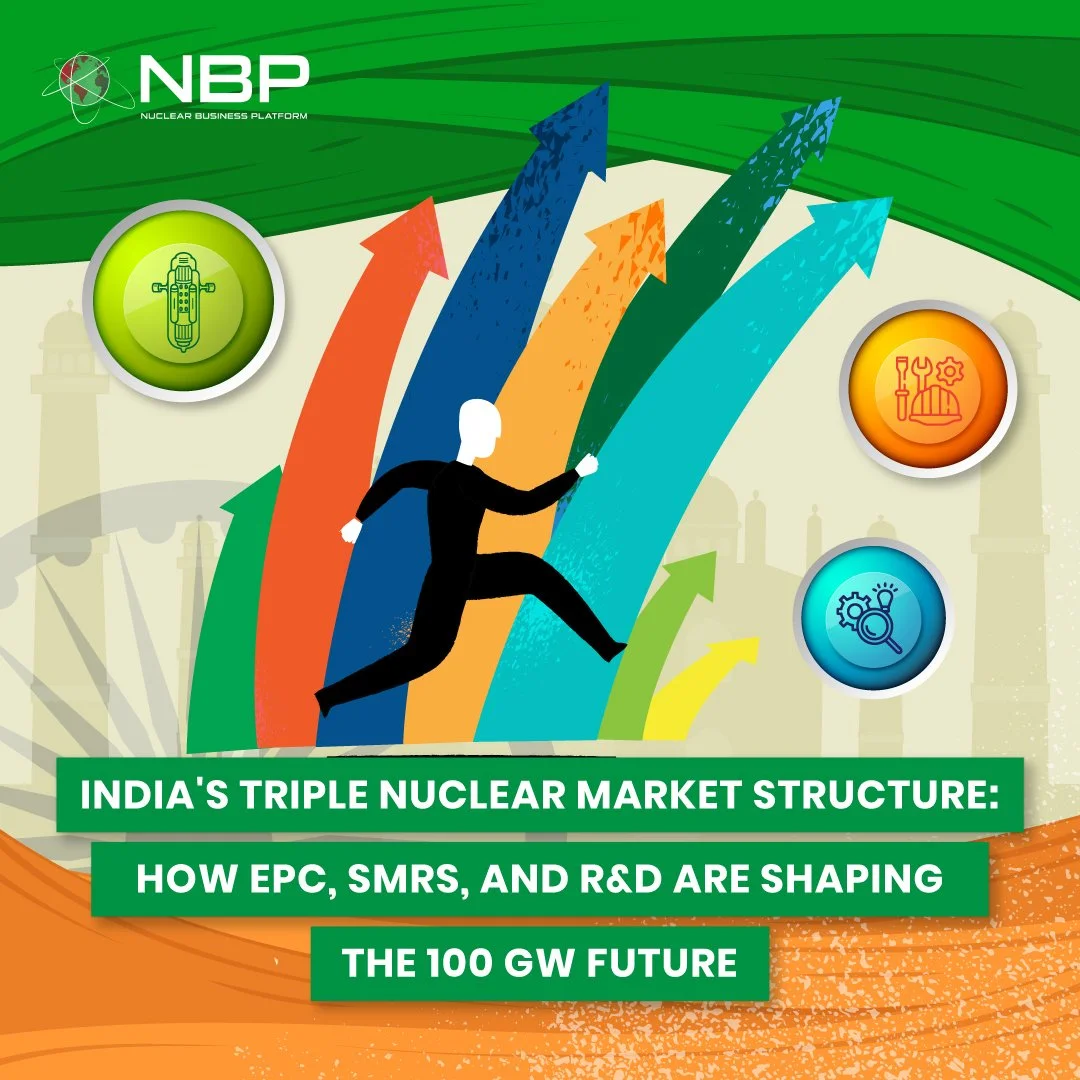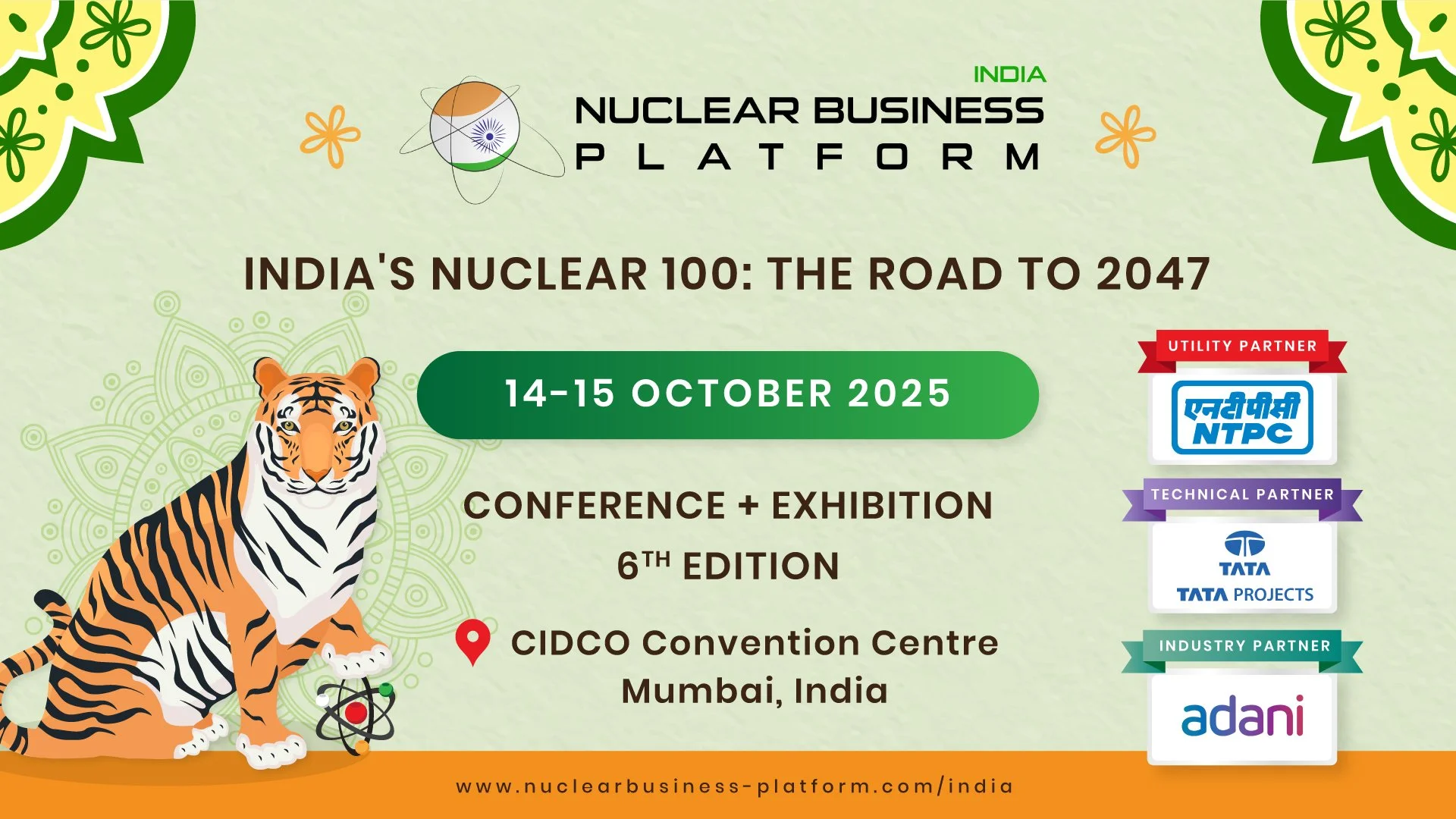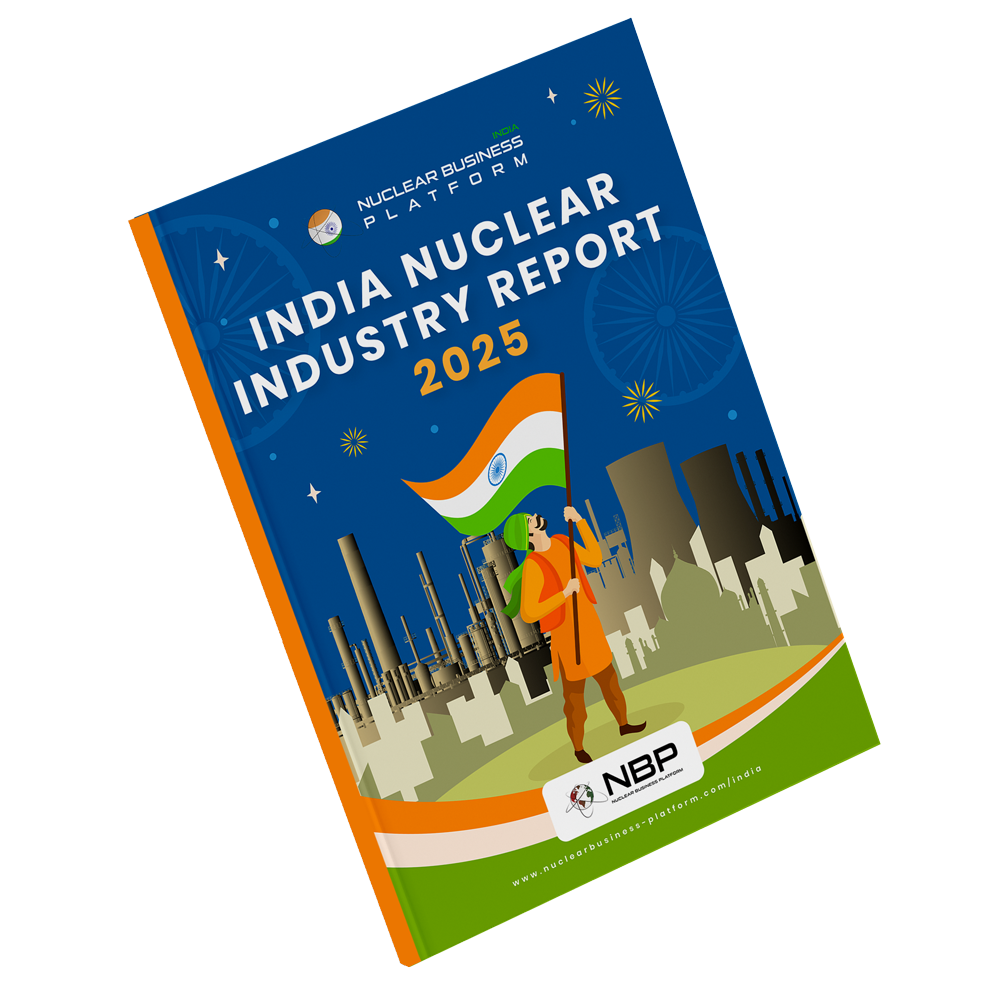India's Triple Nuclear Market Structure: How EPC, SMRs, and R&D Are Shaping the 100 GW Future
India’s nuclear energy landscape is undergoing a quiet transformation—one powered not by a single technology but by a synergistic trio: large-scale EPC (Engineering, Procurement, and Construction) projects, Small Modular Reactors (SMRs), and cutting-edge Research and Development (R&D). With a national target to scale nuclear power capacity to 100 GW by 2047, this triple-market structure is no longer aspirational—it’s strategic. As traditional reactors expand, compact modular technologies emerge, and R&D deepens its scope, India is crafting a self-sustaining and globally competitive nuclear ecosystem. For industry leaders, this convergence presents more than a policy shift—it opens a high-growth business frontier with investment-ready opportunities across the value chain.
EPC Capabilities: Laying the Foundation for Scalable Growth
India’s nuclear sector has matured into a high-potential market shaped by decades of technology denial and self-reliance. That legacy has now evolved into a robust, vertically integrated EPC ecosystem—offering extensive business opportunities across the supply chain. With a national target of 100 GW nuclear capacity by 2047, India is transitioning from isolated projects to an industrialized, investment-ready market. The government’s recent policy shift to enable private capital infusion, while retaining indigenous control, signals a pragmatic approach to scale—opening doors for both domestic and global EPC players.
At the core of this ecosystem is the Nuclear Power Corporation of India Limited (NPCIL), under the Department of Atomic Energy (DAE). NPCIL, with 25 reactors currently in operation (delivering a combined installed capacity of 8,880 MW), commands end-to-end capabilities in design, construction, commissioning, and operation—across both indigenously developed Pressurized Heavy Water Reactors (PHWRs) and imported VVER technologies. Its established regulatory and project execution framework serves as a stable platform for collaborative engagement and risk mitigation.
Indian industrial heavyweights are deeply entrenched in this value chain. Larsen & Toubro (L&T), a key EPC and manufacturing partner, has delivered heavy components for 17 PHWRs and a significant portion of the Prototype Fast Breeder Reactor (PFBR). Its ASME accreditation for nuclear-grade pressure vessels positions it as a global-class supplier. Bharat Heavy Electricals Ltd (BHEL) contributes reactor components and conventional islands, while Hindustan Construction Company (HCC)—builder of over 50% of India’s nuclear capacity—has executed complex civil structures for major projects, including Kudankulam.
A major commercial enabler is the government’s decision to construct ten 700 MW PHWRs in “fleet mode” by 2031 across Haryana, Karnataka, Madhya Pradesh, and Rajasthan. This strategy—built on standardized design, synchronized procurement, and parallel construction—offers EPC and supply chain players significant advantages through economies of scale, repeat contracts, and streamlined approvals. For vendors and component manufacturers, this presents predictable timelines, assured volumes, and the ability to optimize capacity utilization across projects.
India’s largest power utility, NTPC, is aggressively expanding its footprint in nuclear. The company plans to develop 30 GW of nuclear capacity over the next two decades—triple its earlier projection—at an estimated investment of $62 billion. NTPC has also issued tenders inviting global partnerships to co-develop 15 GW of large-scale nuclear capacity using Pressurized Water Reactor (PWR) technology. These initiatives present significant entry points for international reactor vendors, technology licensors, and EPC consortia seeking long-term participation in India’s expanding nuclear power market.
The convergence of established domestic infrastructure, standardized reactor platforms, and liberalized capital policies is creating a scalable nuclear construction market in India—offering sustained commercial opportunities for engineering firms, equipment suppliers, project developers, and foreign collaborators.
Small Modular Reactors (SMRs): Decentralizing and Diversifying Nuclear Power
India is placing SMRs at the center of its next-phase nuclear expansion—creating a new market vertical designed for flexibility, localized deployment, and industrial integration. In a landmark move, the Union Budget 2025–26 earmarked Rs.20,000 crore (approx. USD 2.4 billion) under the Nuclear Energy Mission, with a dedicated focus on SMR research and development. The roadmap includes the deployment of at least five indigenously developed SMRs by 2033—marking a clear political and financial commitment to operationalizing small-scale, modular nuclear power.
SMRs are being positioned not merely as a supplementary energy source but as a high-utility, commercially viable solution for energy-intensive industries, decarbonization, and grid resilience. The Department of Atomic Energy (DAE) is actively developing three SMR variants, each tailored for specific high-value use cases:
Bharat Small Modular Reactor (BSMR-200): A 200 MW scaled-down Pressurized Heavy Water Reactor (PHWR), optimized for captive power in steel, cement, aluminum plants, and off-grid industrial clusters. It incorporates passive safety systems and builds on India's proven PHWR ecosystem—leveraging manufacturing know-how, licensing experience, and operational reliability.
55 MW SMR Variant: Designed for deployment in remote and geographically isolated areas with limited or no grid access, sharing core PHWR design attributes for modular scalability and ease of maintenance.
5 MWth High Temperature Gas Cooled Reactor (HTGR): Tailored for high-temperature hydrogen production, this design signals a strategic expansion of nuclear energy’s role into clean fuel synthesis—particularly relevant for transport and industrial decarbonization.
Choosing PHWR-based SMRs is a deliberate, risk-mitigated strategy. India’s decades of experience with PHWRs reduce design uncertainty, accelerate deployment timelines, and lower costs—providing a competitive edge for both domestic rollout and future export potential. For nuclear EPC firms and component suppliers, this translates to a ready-made design and supply chain with short learning curves and predictable margins.
SMRs offer commercially attractive solutions for large-scale energy users. Data centers, manufacturing clusters, and transport infrastructure—like Indian Railways, which is actively evaluating SMRs for achieving net-zero targets—stand to benefit from flexible, secure, and decentralized energy. Their modular design enables phased deployment aligned with demand growth, while inherent and passive safety features minimize operational risks and reduce the burden of human intervention. For the first time, Indian private industry is being formally integrated into SMR development. NPCIL has invited proposals from private players to finance and support the development of 220 MW Bharat Small Reactors (BSRs). This marks a paradigm shift in India’s nuclear sector—positioning SMRs as the commercial entry point for private capital, innovation, and industrial co-development.
SMRs also open pathways to mass manufacturing and export. Their factory-fabrication potential allows for standardization, repeat orders, and a streamlined supply chain—presenting Indian manufacturers with opportunities to specialize and scale. Over time, this could lead to the emergence of tiered SMR suppliers across design, fabrication, instrumentation, and balance-of-plant services.
On the international front, India is actively pursuing SMR collaboration with key global players:
USA (Holtec International): For SMR-160 technology transfer discussions;
Russia (Rosatom): Exploring thorium-based SMR development.
France: Co-design and co-production of SMRs and Advanced Modular Reactors (AMRs);
These strategic ties not only broaden the technology portfolio but also create new business models around licensing, joint ventures, and cross-border supply chains.
India’s SMR push is not just about diversification—it is about creating a commercially vibrant, modular nuclear market. With clear policy support, industrial partnerships, and a technology roadmap aligned with indigenous strengths, SMRs are emerging as the nucleus of India’s next wave of nuclear sector investment and innovation.
Research and Development (R&D): The Engine of Innovation and Strategic Capability
India’s nuclear research and development ecosystem forms the strategic backbone of its energy self-sufficiency and commercial competitiveness. At the center of this is the Bhabha Atomic Research Centre (BARC), the country’s premier nuclear R&D institution under the Department of Atomic Energy (DAE). With a multidisciplinary mandate, BARC leads the design and development of India’s reactor technologies, while also driving innovation in non-power applications such as medical isotopes, agriculture, and water purification—demonstrating the wide societal relevance of nuclear R&D and reinforcing long-term policy and financial support.
India’s three-stage nuclear program is being actively advanced through dedicated R&D:
Stage 1 – Pressurized Heavy Water Reactors (PHWRs):
India currently operates 20 PHWRs using natural uranium as fuel and heavy water as moderator. These reactors have consistently achieved average capacity factors of ~80%, showcasing their operational maturity. R&D continues to focus on optimizing fuel burnup, extending reactor life, and enhancing passive and active safety systems—consolidating India’s leadership in PHWR technology and reducing reliance on external reactor vendors.Stage 2 – Fast Breeder Reactors (FBRs):
The 500 MWe Prototype Fast Breeder Reactor (PFBR) at Kalpakkam began core loading in 2024 and is on track for commissioning by 2026. This reactor uses plutonium produced in PHWRs to breed more fissile material, including uranium-233 from thorium blankets. As a critical step toward closing the fuel cycle, the PFBR opens new pathways for high-burnup fuels, reprocessing innovation, and energy security.Stage 3 – Thorium-Based Reactors:
India is uniquely positioned to capitalize on its large thorium reserves. The 300 MWe Advanced Heavy Water Reactor (AHWR) is under development as a technology demonstrator for (Th-Pu) and (Th-U-233) fuels. With design features such as natural circulation-based cooling and passive safety systems, the AHWR represents the world’s most advanced effort to commercialize thorium reactors. This reactor class offers export potential to countries seeking proliferation-resistant and sustainable energy solutions.
BARC and DAE’s R&D extends across the entire nuclear fuel cycle—creating multiple entry points for private industry and technology suppliers:
Mining and Raw Material Development:
Uranium Corporation of India Limited (UCIL) is expanding exploration and mining operations, including new projects aimed at securing long-term fuel supply. R&D in rare earths and strategic minerals supports both the nuclear sector and India's clean energy manufacturing ambitions.Fuel Fabrication:
Nuclear Fuel Complex (NFC) is scaling up its capabilities with a greenfield plant in Kota, Rajasthan, to meet the demand for upcoming 700 MW PHWRs. BARC has also inaugurated a Sub-assembly Level Metal Fuel Fabrication Facility—key for advanced reactors and fast reactors using metal fuels.Reprocessing and Waste Management:
India’s closed fuel cycle policy treats spent fuel as a resource. Operational facilities like CORAL (for carbide fuel) and the Demonstration Fast Reactor Fuel Reprocessing Plant (DFRP) for oxide and carbide fuels demonstrate India’s technical depth. Advanced reprocessing R&D is reducing waste volumes and long-term storage needs, improving economics, and supporting sustainable fuel use.Advanced Technologies:
R&D is ongoing in high-priority areas such as hydrogen production (via nuclear heat and thermochemical processes), cryogenics, reactor-grade material development, advanced welding techniques, and indigenous detector and instrumentation technologies. These innovations are critical enablers for SMRs, AMRs, and hybrid nuclear-industrial systems.
For businesses, India’s R&D architecture offers direct alignment with long-term market growth. With the government backing early-stage development and demonstration, private and international companies can engage at the commercialization phase—through co-development, licensing, and supply chain participation.
India’s research-driven nuclear ecosystem is not only ensuring self-reliance but actively building a globally relevant innovation pipeline. For companies seeking long-term stakes in advanced reactor platforms, fuel cycle solutions, or nuclear-integrated industrial applications, India presents a structured, state-supported, and commercially evolving environment.
India's Triple Nuclear Market — A Structured Growth Platform
India’s nuclear sector presents a uniquely structured growth platform where three verticals—EPC expansion, SMR development, and R&D innovation—are advancing in parallel. Together, they form a triple-market dynamic offering diverse, long-term business potential. From large-scale reactor construction and grid-flexible SMRs to advanced fuel cycle technologies, the Indian nuclear value chain is opening up multiple high-value entry points for global and domestic stakeholders.
The government’s target to scale up nuclear capacity to 100 GW by 2047 signals an ambitious, sustained expansion. Crucially, the completion of amendments to the Atomic Energy Act of 1962 and the Civil Liability for Nuclear Damage Act (CLNDA) 2010 is expected to unlock faster, broader, and more inclusive participation, creating a more conducive environment for private investment and international collaboration.
A key milestone in this journey will be the 6th India Nuclear Business Platform (INBP) 2025, scheduled for 14–15 October in Mumbai, which will serve as a strategic forum for connecting policy, technology, and capital. As these three markets continue to evolve in unison, India stands out not only as a nuclear-ready nation but as a high-opportunity destination for future-focused nuclear business.



